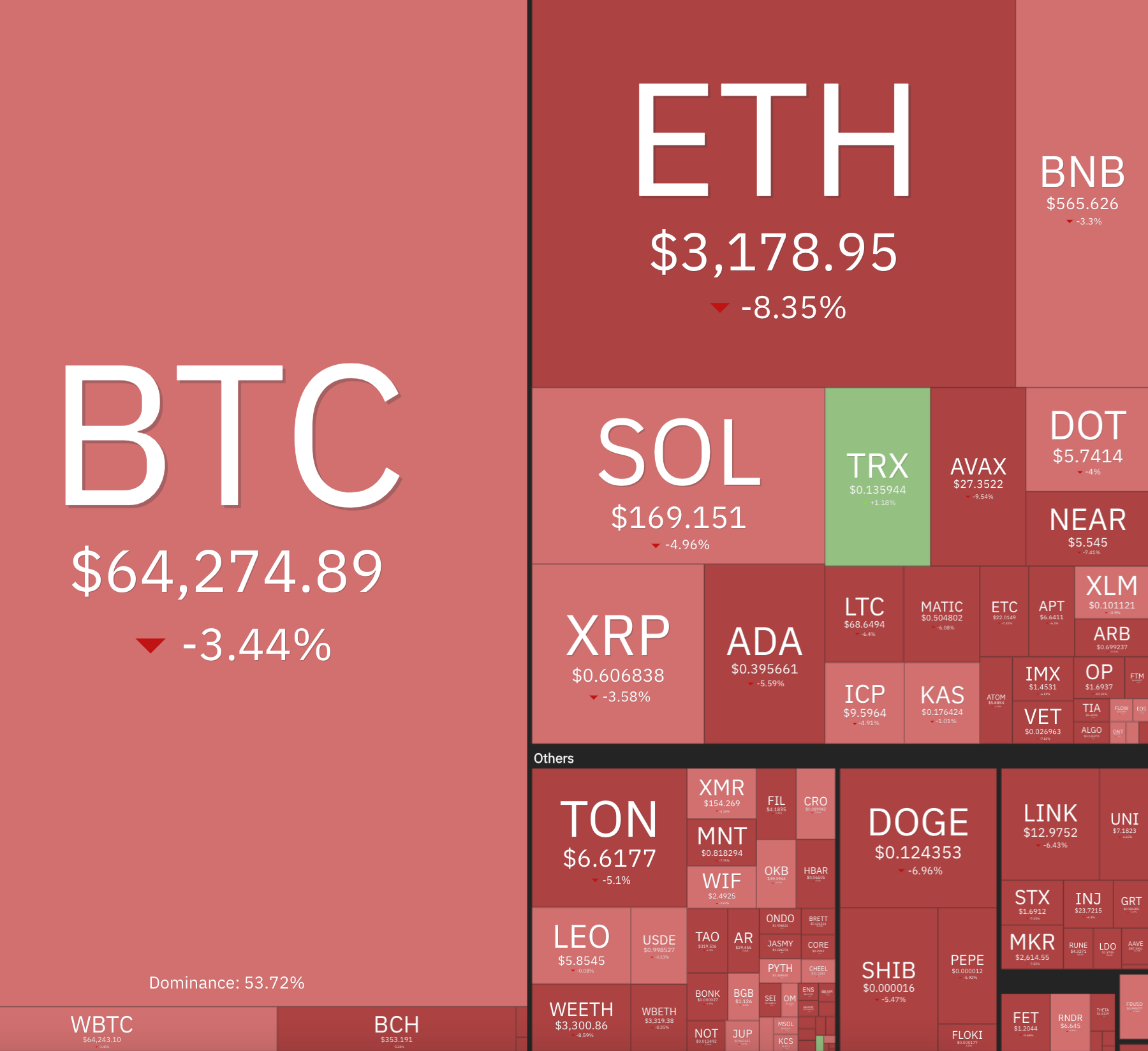Tài sản rủi ro giảm vào thứ năm khi Trung Quốc cắt giảm lãi suất lần thứ hai trong một tuần làm dấy lên lo ngại về sự bất ổn ở nền kinh tế lớn thứ hai thế giới.
Bitcoin, loại tiền điện tử hàng đầu theo giá trị thị trường, đã giảm 3,4% trong ngày xuống còn 64.274 đô la và ETH giảm hơn 8% xuống 3.178 USD, kéo thị trường altcoin rộng lớn hơn trượt thấp hơn.

Nguồn: Coin360
Trên thị trường chứng khoán, chỉ số DAX của Đức, CAC của Pháp và Euro Stoxx 50 của khu vực đồng euro đã giảm hơn 1,5% và hợp đồng tương lai gắn liền với chỉ số công nghệ Nasdaq 100 cũng giảm nhẹ.
Sáng nay, Ngân hàng Nhân dân Trung Quốc (PBoC) đã bất ngờ công bố cắt giảm lãi suất cho vay trung hạn một năm từ 2,5% xuống 2,3%, bơm 200 tỷ nhân dân tệ (27,5 tỷ đô la) thanh khoản vào thị trường, đánh dấu mức giảm lớn nhất kể từ năm 2020.
Động thái này, cùng với việc cắt giảm các mức lãi suất vay khác vào đầu tuần này, cho thấy sự cấp bách trong giới hoạch định chính sách nhằm thúc đẩy tăng trưởng sau khi phiên họp toàn thể lần thứ ba gần đây của họ không mang lại nhiều hy vọng về kích thích kinh tế. Dữ liệu được công bố vào đầu tháng này cho thấy nền kinh tế Trung Quốc đã chứng kiến tốc độ tăng trưởng hàng năm là 4,7% trong quý 2, thấp hơn nhiều so với mức ước tính 5,1% và chậm hơn mức 5,3% của quý 1.
“Hợp đồng tương lai cổ phiếu ổn định sau phiên giao dịch đẫm máu ngày hôm qua đã làm rung chuyển quan điểm trên tất cả các loại tài sản”, Ilan Solot, chiến lược gia toàn cầu cấp cao tại Marex Solutions, cho biết. “Quyết định cắt giảm lãi suất bất ngờ của PBoC chỉ làm tăng thêm cảm giác hoảng loạn”.
Marex Solutions là một bộ phận của nền tảng tài chính toàn cầu Marex, chuyên tạo và phân phối các sản phẩm phái sinh tùy chỉnh và phát hành các sản phẩm có cấu trúc liên kết với tiền điện tử.
Solot lưu ý rằng “đường cong lợi suất trái phiếu kho bạc Hoa Kỳ đang ngày càng dốc” là mối đe dọa đối với các tài sản rủi ro, bao gồm cả tiền điện tử.
Đường cong lợi suất dốc hơn khi chênh lệch giữa lợi suất trái phiếu dài hạn và ngắn hạn tăng lên. Tháng này, chênh lệch giữa lợi suất trái phiếu kho bạc kỳ hạn 10 năm và 2 năm đã tăng 20 điểm cơ bản lên -0,12 điểm cơ bản (bps), chủ yếu là do lợi suất trái phiếu kỳ hạn 10 năm có sự ổn định cao hơn.
Lịch sử cho thấy hiện tượng đường cong lợi suất dốc lên lại từ trạng thái âm (hoặc chênh lệch âm) thường xảy ra đồng thời với tâm lý sợ rủi ro.
“Đối với tôi, mối quan tâm lớn nhất là hình dạng của đường cong lợi suất trái phiếu Hoa Kỳ, đường cong này tiếp tục dốc hơn. Đường cong 2 năm và 10 năm không chỉ bị đảo ngược -12bps, so với -50bps chỉ trong tháng trước. Sự thay đổi này cho thấy rằng lãi suất dài hạn (10 năm) đang tăng nhanh hơn so với lãi suất ngắn hạn (2 năm), góp phần làm tăng độ dốc của đường cong lợi suất”, Solot cho biết, nhấn mạnh đó là dấu hiệu cho thấy thị trường kỳ vọng Fed sẽ cắt giảm lãi suất nhưng lại coi lạm phát dai dẳng và chính sách tài khóa mở rộng là những rủi ro ngày càng tăng.
Itadori
Theo Coindesk